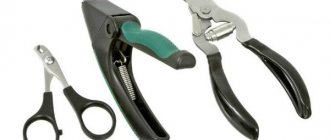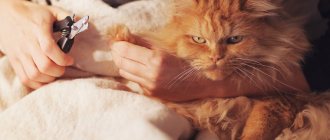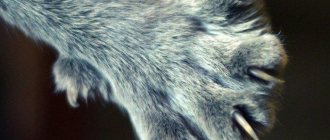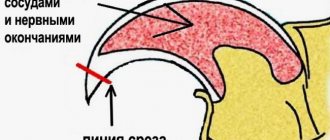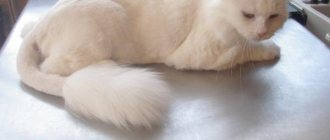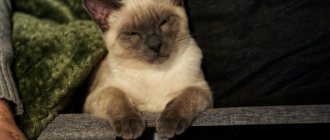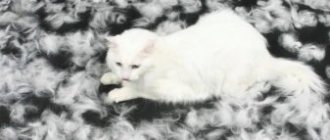Once you have a cat in your home, it brings with it the attendant dilemmas regarding nail care. The most significant problem for cat owners is torn wallpaper, sofas, beds, all kinds of carpets and cabinets, and endless scratches when trying to play with their pet.
This article details how to accurately trim an animal's nails at home without causing harm to yourself or your furry friend. At what age can you trim a kitten’s nails and how to choose the right clipping tool.
Why do you need to cut your hair?
Nature has taken care of every living creature, and a cat’s claws were not given for beauty. In natural habitats, claws help a cat hunt for prey and escape from stronger opponents. With the help of its claws, the animal easily climbs a tree, escaping the dog and other enemies. But why do they need a domestic cat, who sees the whole world only from the apartment window?
Many owners believe that claws only bother a cat. And you can’t count how many troubles they cause for owners of furry pets:
- cling to carpets, curtains, upholstered furniture;
- During games, they can accidentally or deliberately scratch or injure a person.
Untrained cats often mistake a sofa, armchairs or carpet for a scratching post. And even if you place scratching posts in every room, the pet will leave marks of sharp claws on the furniture. There is only one way out - trim the claws so that they are not so sharp.
For animals participating in exhibitions, trimming their nails is a mandatory procedure. It is also recommended to do this:
- before mating;
- a visit to the veterinarian.
Small kittens, although they still have softer claws than adult cats, are also recommended to trim them so as not to injure the mother cat during feeding, and at the same time accustom them to manipulation. The sooner this is started, the less resistance the owner will encounter from the pet later during cosmetic procedures.
Important!
In no case should the claws of cats that have the opportunity to walk outside be trimmed: this can deprive them of the ability to defend themselves, which can lead to serious injuries and even death of the pet.
The need for nail clippers
Naturally, claws wear down during fairly long walks on concrete or asphalt. However, this is often not enough. Considerable attention should be paid to the claws on the lateral or dewclaws. The dogs don't reach the ground, so they don't wear off. As the dewclaws grow, they sometimes grow into the skin, causing pain if they are allowed to grow excessively. Under any circumstances, attentive dog owners have a tool that can help keep their pet's paws and claws in perfect order. This is a nail clipper.
Is it possible to cut a cat's claws - pros and cons
So, is it worth trimming a cat’s claws and how to do it. Positive aspects:
- Pets are not able to sharpen their claws to the required length themselves. They grow very long in cats, this can easily lead to their ingrowth into the pads and delamination. If you don't trim your cats' claws, they will eventually interfere with their ability to move, regularly clinging to carpets, furniture and everything else.
- The need to trim nails most often arises only when they are very peeling or very injured.
- Quite often, before owners decide to trim their cat’s claws, they have time to say goodbye to the upholstery on the sofa, wallpaper in the bedroom, parquet flooring and jambs. All these things were ruined by the cat, and when guests arrive you can immediately see who’s boss.
- If there are children in the house, then the question of whether or not to cut the cat’s claws disappears by itself. Because a constantly scratched child leaves no choice for his parents.
- Before exhibitions, nail trimming is mandatory. This is an argument for those who own elite or purebred animals.
Opponents of this procedure provide no less weighty arguments:
- Even if the owner is fluent in the art of trimming cats' claws, injury cannot be avoided. Because the keratinized part is two or three millimeters long. After an injury, the claw can easily become infected.
- The nail trimming procedure itself can be very painful for a pet, since the claws contain all the nerve endings. Even if you know how to trim her nails correctly, be very careful because she will not have the best memories of the procedure. And this will need to be done regularly.
- Immediately after the claws are trimmed, they become less functional, and it will be very difficult for your beloved pet to cling to various objects. The animal will not immediately understand its limitations; it may try to jump somewhere and not be able to resist. So is it okay to have your cat's nails trimmed if it increases the risk of injury to your pet?
- After your pet has undergone this procedure once, you will have to do it regularly, twice a month.
- Now think about what will be more annoying, unpleasant periodic procedures or scratched furniture?
First aid for injuries
Most dogs are very worried before trimming their nails , even if they have not experienced negative emotions about this before. One option is relaxation medications. As a rule, sedatives are produced from herbs and weaken nervous excitability, all this gives exactly the effect that is required for a cosmetic procedure. Then prepare special powder, powder or wipes with hemostatic properties. If you cut the claw too deeply, several dozen important vessels will be damaged. Quite often, injuries are accompanied by severe bleeding, and this initiates mutual panic for both dog and owner.
It is important to know that under no circumstances should you treat a damaged claw with the following drugs:
iodine;- fucorcin;
- hydrogen peroxide;
- dimexide;
- alcohol;
- brilliant green;
- vodka.
If you don’t have special powder or baby powder nearby, then ordinary food flour will do. All kinds of cauterizing and alcohol-containing solutions will only increase the pain!
Another rather difficult injury is claw tearing . Most often, this happens if you squeeze the nail clippers for a long time, and the dog suddenly jerks its paw. The secured claw remains in the clamp, and the soft tissue and skin are torn.
The first thing to remember is that this is very painful for the dog! Get ready for your tailed friend to whine loudly and try to run away. Operate quickly enough and without panicking:
- Constantly talk to the dog, console him, do everything in order to distract him from what is happening.
- Intercept the wounded paw with a piece of gauze in the area of the wrist (metatarsus).
- Tighten and secure the gauze thoroughly, while it is recommended to raise the limb as high as possible. Apply cold to the injured paw - ice, a piece of minced meat, frozen vegetables taken from the freezer. Wrap the compress in cotton cloth and cellophane in advance. Cold can help stop blood flow and moderate the pain to some extent.
- Carefully examine the wound, and if there are open tissue tears, fill them with novocaine or lidocaine.
When trimming my cat's claws, my cat began to bleed, how can I stop it?
Any cosmetic procedure for an animal requires maximum attention and accuracy.
- Nail trimming is a traumatic procedure. The risk of injuring your pet is quite high.
- The reason for this may be a poor-quality tool, too large a cutting angle, touching the blood vessels in the claw, or simply your pet was scared of something and twitched.
- Similar cases can occur both in an experienced owner and in a novice.
If such a situation occurs, do not panic. Inspect the site of injury if possible. If the wound is shallow, treat it with hydrogen peroxide and bandage it, calm the animal. If you see that the bleeding does not stop, after pre-treatment, apply a bandage to the sore spot and, as soon as possible, contact a specialized clinic. The veterinarian will carry out all the necessary procedures and advise how to prevent a recurrence of the incident.
The main thing is not to panic
Instructions for using a nail clipper
When starting the procedure, it is necessary to keep some kind of hemostatic agent and antiseptic nearby each time. The first would be substances such as:
- talc;
- baby powder;
- potassium permanganate, etc.
We sit opposite the light and hold our paw. Gently press on the pad. The claw extends. It needs to be viewed against the light. Even on dark claws it is possible to recognize a blood vessel; on light claws it is diagnosed by its pinkish tint. This is the edge of the stratum corneum that should not be crossed. Carefully begin to cut the claw at right angles to its surface, cutting a little at a time.
Due to the difficulty of finding the exact border of blood vessels on dark claws, you need to be extremely careful and pause the procedure if a dark dot or a light circle appears in the middle of the section, in which the vessels are visible. There's no need to rush. It is safer to trim 1-2 claws at a time with a nail clipper, taking pauses. At the end, it makes sense to trim the cropped edges with a nail file. If you cut too much and touch a nerve, your pet will experience severe pain and will become wary of having its nails trimmed. In this case, it is necessary to take a break, console the pet, treat it with a treat, and play. After one hour, try to cut it again, only this time more carefully.
For the very first time, it makes sense to go to a salon for four-legged friends or to a veterinarian, watch how a professional operates the nail cutter, and then you can cut the claws yourself.
Features of the structure of cat nails and rules for cutting them
After checking the tools, you can slowly begin processing. The first step is to properly “set up” the pet itself.
How to prepare a cat
You will have to “catch” the right moment: it is advisable that the cat be a little tired, sleepy, or at least calm when the haircut begins.
But you can’t interrupt his games and almost forcibly start cutting - the natural reaction will be rejection, and the animal simply won’t give in to your hands a second time.
Important! The most practical tools are those with rubber lining on the handles. Your hand may slip off steel surfaces. Wanting to avoid unnecessary injuries (both to themselves and to the cat), some owners swaddle their pets
This is also a good method that is used before trimming a cat’s claws at home.
Wanting to avoid unnecessary injuries (both to themselves and to the cat), some owners swaddle their pets. This is also a good method that is used before trimming a cat’s claws at home.
This procedure will be unclear to the cat at first, and you should not expect him to immediately raise his claws. You will have to stroke the paws, slowly moving onto the pads, which lightly press down (until the claw appears). This simple method is especially useful for small kittens: they get used to it and there are no special difficulties with them.
At the very start you will have to calm and caress the animal. It’s also useful to talk - this kind of “explanatory work” also helps. Be patient, especially if you are dealing with an older cat.
Did you know? Trained cats can replace sniffer dogs. One of these professionals was Rusik, who in 2001–2003. helped find fish from poachers smuggling their catch through a police picket in Stepnovo.
Pruning rules
Before trimming a cat's claws, take a disinfected tool with clean hands.
Then proceed like this:
The paw is held firmly, but gently. It should not twitch or slip out. Lightly press the center of the pad with two fingers so that the claw is fully exposed. Now a little anatomy. If you look closely in the light, you can see the free edge of the claw and the pink tissue inside it. This is a pulp with nerve endings and vessels, we do not touch it. The edge is removed so that at least 2 mm remains to the pulp. If the cat has dark claws, you have to act by touch, in 2-3 approaches, cutting off 1 mm each time. At the same time, scissors or a trimmer are held from above and perpendicular, trying to trim “in one fell swoop.” This is a matter of habit - after a few sessions it will be faster. At the end of the procedure, we adjust the edges to make it more comfortable for the cat to walk without clinging to its paws.
Due to inexperience, you can injure your paw. It’s unpleasant, but don’t panic—fill it with peroxide and calm the “patient.” The bleeding goes away quickly.
There seem to be no difficulties, but for the first time you will need the help of loved ones who will hold the cat.
Important! In some breeds, the pads become very overgrown and the hairs cover the claw. A clipper can help here (of course, if the animal is not afraid of it).. Don’t forget to trim all the claws, 5 on the front paws and 4 on the back
Beginners often forget about this “asymmetry” and, without looking closely, leave an old claw in front, which over time causes discomfort to the animal.
Don't forget to trim all the claws, 5 on the front legs and 4 on the back. Beginners often forget about this “asymmetry” and, without looking closely, leave an old claw in front, which over time causes discomfort to the animal.
Top articles: Phenotype: definition, examples, relationship with genotype and genetic diversity
Reward for good behavior
During the operation, do not forget to praise your pet, even if he becomes restless.
To smooth out the first stress a little, give him a vitamin, or even better, a treat you have prepared in advance (what your pet adores). This will slightly accustom the cat to the idea that a haircut is not so scary.
Find out what to do if you find your pet has problems such as ringworm or ear mites.
What to do if your cat resists
If your cat won’t let you cut her nails, you can try to accustom her to this procedure gradually, the main thing is to be patient.
Try a few simple tricks:
- If your cat doesn’t have enough patience for a long time, start small. To begin with: cut two claws and release the pet, not forgetting to praise. Then cut off more, and increase the number of toes until you have processed all the paws.
- Wait until the cat has no desire to resist when she has eaten and becomes sleepy.
- Try trimming nails while your cat is sleeping.
- If your cat becomes stressed due to the procedure, you can try giving him sedatives using natural herbs, for example, “Cat Bayun”.
- If you catch a kitten in a playful mood, you should postpone claw trimming until the kitten becomes less agitated.
We hope that our article will help you develop an effective strategy for trimming your pet's nails. If your cat won’t let you get close to his manicure with scissors or has an aggressive character, then we recommend reading our article about silicone anti-scratch pads (harmless to the pet’s body and a solution for responsible owners). Share with us and our readers in the comments: what tricks do you practice when trimming your cats’ claws?
Is there an alternative: “soft paws” and “anti-scratch pads”
In fact, there is only one alternative and how humane it is is the question. We are talking about an operation to remove claws - onychectomy. The need for it may arise in case of severe claw disease, traumatic damage to the fingers, or excessive aggressiveness of the animal. But in recent years, some animal owners are doing this without medical indications, but only to prevent their animals from damaging their furniture.
The glamorous name “soft paws” actually hides the amputation of the last claw phalanx on the animal’s toes. The operation is performed under general anesthesia, which in itself is a serious test for the animal’s body. Removal of claws can lead to a number of diseases and affect the psyche and behavior of an animal deprived of an innate tool, but not the need to use it.
A more humane method to prevent damage to hands and furniture is silicone claws or “anti-scratches.” These are silicone caps that are glued to the claw with special glue. They produce several sizes for cats of different ages and breeds, and all kinds of colors. Multi-colored caps not only allow you to be creative in choosing a manicure, but also make it easier to find and clean up fallen nails. The latter is especially true for families with small children and other animals who may pick up and eat something from the floor.
The gluing procedure is in many ways similar to trimming nails and is no less stressful for the animal. It should be taken into account that silicone pads change the animal’s tactile sensations when walking, playing, and affect jumping and the ability to climb objects.
Experts have differing opinions regarding silicone claws. On the one hand, there is no particular harm from them, and in comparison with “soft paws” they are completely harmless. But, on the other hand, for the animal it is stress and suppression of instincts.
Perhaps reviews from more experienced cat owners will help you decide on the need for the procedure. But remember that “anti-scratches” do not solve the problem at the root. It is still necessary to trim your cat's claws, as they continue to grow under the silicone.
Cat declawing. Consequences
In addition to regular trimming of a cat's claws, there are radical methods - removing the animal's claws. Often, the reasons for such drastic methods are: damage to home furniture, aggressive behavior towards children. The operation to remove claws from cats is called onychectomy. Let's take a closer look at what such a procedure is and what possible consequences exist. There are a number of conditions necessary for such an operation:
- the animal must be domestic. Even if the opportunity to visit the street for a four-legged friend is given once a year - when traveling to the country - such an operation is contraindicated for you.
- If attacked by other animals, the cat simply will not be able to defend itself.
Danger often awaits residents of city apartments on the street
- Your four-legged friend must be healthy. The operation is performed under general anesthesia, which is already dangerous for the animal.
- Young felines tolerate this kind of intervention more easily.
- The young age of the animal helps it quickly adapt to the changes that have occurred and the rehabilitation process is more successful.
The operation itself involves removing the claw along with the adjacent part of the finger. If compared to a person, this is equivalent to removing the last phalanx of a finger. In other words, the animal obviously becomes disabled.
- The postoperative period in cats lasts about 3 - 4 weeks.
- The animal will be able to stand on its paws and try to walk only on the third day.
- All this time the pet will need care and attention.
- If the procedure was successful, the lameness will go away within a week.
- The entire time rehabilitation lasts, the cat suffers from unbearable pain, which painkillers can drown out.
Alternative Methods
If your cat categorically refuses to get a pedicure and it is inconvenient to take him to the veterinary clinic every month, you can consider alternative methods:
- Antitsapapki. Special overlays (caps) prevent damage to the furniture, but it is uncomfortable for the animal to walk, and the horny plates still grow and need to be cut off.
- Onychectomy or soft paw surgery. A difficult procedure for the animal, during which part of the cat’s fingers is taken away. Animals' paws become deformed, they lose coordination, and suffer from pain. Condemned by many veterinarians and breeders. In a number of countries the operation is prohibited.
Why trim a cat’s claws: is it necessary to do it?
Is it worth taking up scissors if there are special boards in the house? But many pets simply ignore them, and some, even paying attention to them, still strive to tear off the carpet or the owner’s sofa. The plates that scratch our skin and leave marks on all horizontal and vertical surfaces in the house grow throughout our lives
During this time they have undergone more than one update. To make this process happen as quickly as possible, animals sharpen their claws. In their natural environment, representatives of the cat family do this by climbing tree trunks and simply traveling - with their paws in direct contact with hard and dry ground. But furry homebodies do not have this. Therefore, they spoil what is not intended for such procedures - furniture, carpets and other interior items
The plates that scratch our skin and leave marks on all horizontal and vertical surfaces in the house grow throughout our lives. During this time they have undergone more than one update. To make this process happen as quickly as possible, animals sharpen their claws. In their natural environment, representatives of the cat family do this by climbing tree trunks and simply traveling - with their paws in direct contact with hard and dry ground. But furry homebodies do not have this. Therefore, they spoil what is not intended for such procedures - furniture, carpets and other interior items.
Another reason why pet owners decide to get a haircut is numerous scratches. Also, do not forget that the tips of the ridges grow, and then they can break, bend or flake.
Mechanical damage to the plate during walking, playing, or an unsuccessful procedure to remove the keratinized end can lead to bleeding and severe pain. By retracting such a claw, the animal injures the so-called security hole, after which inflammation develops and swelling appears. Be careful and monitor your pet's behavior. If the overgrown plates are too long and constantly cling to your clothes, carpet pile or furniture upholstery, take your pet to a veterinarian who will tell you how to avoid injury.
Another reason why owners sometimes have to pick up scissors is the existence of a fifth claw. It is located on the side of the front legs and differs from others in that it does not scratch, but is actively growing. If it reaches a certain size, the cat will experience discomfort when walking.
We found out whether it is possible to trim cats’ claws, but is it necessary to do it yourself if there are other options that are more gentle? If you don’t want to spend money on buying special houses and posts and are confident that you will do everything right, you can try to “disarm” your pet. Otherwise - if you know that you will not be able to hold the cat, and are afraid of hurting him by damaging the plate - it is better not to risk it.
Instructions for using a nail clipper
When starting the procedure, it is necessary to keep some kind of hemostatic agent and antiseptic . The first would be substances such as:
- talc;
- baby powder;
- potassium permanganate, etc.
We sit opposite the light and hold our paw. Gently press on the pad. The claw extends. It needs to be viewed against the light. Even on dark claws it is possible to recognize a blood vessel; on light claws it is diagnosed by its pinkish tint. This is the edge of the stratum corneum that should not be crossed. Carefully begin to cut the claw at right angles to its surface, cutting a little at a time.
Due to the difficulty of finding the exact border of blood vessels on dark claws, you need to be extremely careful and pause the procedure if a dark dot or a light circle appears in the middle of the section, in which the vessels are visible. There's no need to rush. It is safer to trim 1-2 claws at a time with a nail clipper, taking pauses. At the end, it makes sense to trim the cropped edges with a nail file. If you cut too much and touch a nerve, your pet will experience severe pain and will become wary of having its nails trimmed. In this case, it is necessary to take a break, console the pet, treat it with a treat, and play. After one hour, try to cut it again, only this time more carefully.
For the very first time, it makes sense to go to a salon for four-legged friends or to a veterinarian, watch how a professional operates the nail cutter, and then you can cut the claws yourself.
How much does it cost to trim nails at the vet?
Nail trimming in a veterinary clinic is a guarantee of a high-quality and safe procedure. Doctors use professional nail clippers with particularly sharp sharpening. A grooming salon can also help with this manipulation.
The average price of a haircut in Russia is about 300 rubles. In some small clinics, claws can be trimmed for 50 rubles, and in large centers the cost of cutting claws reaches 350-500 rubles.
If the pet is aggressive, and the owner cannot restrain it himself, ensuring the safety of the doctor, additional restraint may be required, which is paid for in most veterinary institutions.
Other solutions
Cats have a natural instinct - they take care of their claws themselves. Starting from the age of one month, kittens sharpen them with their teeth, scratch the bedding, use a scratching post or other objects, removing the dead outer shell of the claw.
To preserve furniture and other interior items from damage, owners are looking for various options. A good method of training and protecting furniture is a scratching post. You can buy it at a pet store or make it yourself. A board or post with a rough hard covering is installed in a place accessible to the pet. If you teach your kitten to use the device from childhood, you can keep the sofa and wallpaper in the room.
Pet stores sell special silicone claw covers. Their advantage is that the cat can calmly play with small children and sharpen its claws on any surface without fear of leaving damage. However, it is not recommended to use them for a long time, and even more so, you should not put the pads on animals that are walking on their own: in case of danger, the cat will not be able to climb a tree or rise to a different height.
Best articles: TOP 10 fastest animals on the planet
The most cruel decision of the owners is to remove the claws. In most countries of the world, this manipulation is strictly prohibited and is punished as cruelty to animals. During the operation, not just a claw is removed, but part of the phalanx - almost the same as cutting off a person’s fingers. This cripples the animal and makes it disabled.
After onychectomy, performed under anesthesia, which in itself is dangerous for the cat, the structure of the skeleton is disrupted, and this negatively affects the functioning of all body systems. The cat is not only exposed to stress and danger - its coordination and sense of balance are impaired, it can fall even from a small height and be seriously injured.
Animals' character changes, they become irritable and even aggressive. Therefore, it is much easier to teach a kitten to use a scratching post from an early age and regularly trim its sharp claws.
Haircutting tools
Professionals emphasize that the devices from a manicure set are not suitable for this. But they are being a little disingenuous if they say that if used carefully they will not cause harm. Professional clinics use special trimmers, but not everyone has this at home. Therefore, such devices are predominantly used.
Nail cutter - specialized scissors for trimming claws, made of steel.
Guillotine trimmer - ideal for beginners. When you press the handle, a special blade extends, which removes a certain section.
Nail clippers are also suitable for this task, but they need to be held at a certain angle, perpendicular to the nail. If you tilt them at a greater angle, the plates of the claw may begin to peel off, which will lead to injury.
Nail file - used to adjust the shape.
There is a certain limitation for this kind of devices; they must be rigid. Animals have much stronger claws than humans.
Before use, be sure to disinfect the instrument and wipe it with a special antiseptic solution or alcohol. It is also important to stock up on peroxide and cotton wool.
Something sharp with the letter “k”: features of the anatomical structure
Opponents of such an extreme measure claim that it is painful for the animal, because during the “execution” it experiences nothing but pain and fear, and frequent cutting can lead to damage to blood vessels. Is it so? Let's turn to anatomy to make sure that not everything is so simple.
We all know that the claws are located on all four legs of the beast, which can control them like Wolverine from Marvel comics - retracting and releasing. In the first case, they are hidden in the folds of the skin. At such moments, the cat’s paws are soft - nothing threatens both you and your furniture.
An interesting fact is that cheetahs, although they belong to the cat family, differ from all their counterparts, including domesticated ones, in that their claws do not retract.
The claw is hidden under the influence of a tendon, which also allows the cat to release the tip, which is dangerous for home textiles and your hands, when the animal is excited or ready to attack its prey.
The claw is shaped like a sickle - which is why it is so convenient for them to hold something and injure the enemy during a fight. The part that we see consists of the living part and the stratum corneum. The first contains the processes of nerve fibers and blood vessels, the second is subject to grinding and is shed from time to time, like an old snake skin.
So all the fears of those who oppose cutting are quite logical and justified. The plate must be cut carefully so as not to touch the nerve endings or damage the translucent vessel.
Pets belonging to some breeds may have serious problems with their claws: they can peel off and grow until it begins to cause discomfort to the animal. Most often, this happens to Persians if they lack vitamins B or D. If you have a Sphynx or other hairless cat, you need to check your pet’s paws for the formation of a secretion produced by the sebaceous glands - it accumulates in the comb bed and is removed every three days .
First aid for injuries
Most dogs are very worried before trimming their nails, even if they have not experienced negative emotions about this before. One option is relaxation medications. As a rule, sedatives are produced from herbs and weaken nervous excitability, all this gives exactly the effect that is required for a cosmetic procedure. Then prepare special powder, powder or wipes with hemostatic properties. If you cut the claw too deeply, several dozen important vessels will be damaged. Quite often, injuries are accompanied by severe bleeding, and this initiates mutual panic for both dog and owner.
It is important to know that under no circumstances should you treat a damaged claw with the following drugs:
iodine;- fucorcin;
- hydrogen peroxide;
- dimexide;
- alcohol;
- brilliant green;
- vodka.
If you don’t have special powder or baby powder nearby, then ordinary food flour will do. All kinds of cauterizing and alcohol-containing solutions will only increase the pain!
Another rather difficult injury is claw tearing. Most often, this happens if you squeeze the nail clippers for a long time, and the dog suddenly jerks its paw. The secured claw remains in the clamp, and the soft tissue and skin are torn.
The first thing to remember is that this is very painful for the dog! Get ready for your tailed friend to whine loudly and try to run away. Operate quickly enough and without panicking:
- Constantly talk to the dog, console him, do everything in order to distract him from what is happening.
- Intercept the wounded paw with a piece of gauze in the area of the wrist (metatarsus).
- Tighten and secure the gauze thoroughly, while it is recommended to raise the limb as high as possible. Apply cold to the injured paw - ice, a piece of minced meat, frozen vegetables taken from the freezer. Wrap the compress in cotton cloth and cellophane in advance. Cold can help stop blood flow and moderate the pain to some extent.
- Carefully examine the wound, and if there are open tissue tears, fill them with novocaine or lidocaine.
Can a cat have its nails trimmed and why?
The need to sharpen a cat's claws is genetic. However, most city pets spend most of their lives indoors. Consequently, they do not lead such an active lifestyle as their wild counterparts. However, the need to grind down the claws remains. Owners of domestic cats are accustomed to watching their pets independently solve problems with their claws - sharpening them wherever they want. The following are used: furniture upholstery, short-pile carpets, wallpaper on the walls and even the jambs of wooden doors are “attacked” by furry predators. Damage to upholstered and other furniture in the house is a serious reason to monitor the condition of an animal’s claws.
Damaged furniture is the result of ignoring the needs of the animal
Their special structure speaks in favor of caring for cat claws. As you know, the fifth claw on the front paws is separate from the other four and is inactive. However, it is necessary to monitor its length to prevent the claw from growing into the skin. Which can cause discomfort to the animal. This claw does not need frequent length correction; it can be trimmed along with the rest. A broken claw is also a reason to trim it. You can and should trim your cat's claws. After all, the health of the furry pet depends on the patience and attentiveness of the owner.
Conclusion
Do I need to trim my cat's back claws? Many cat lovers ask whether it is necessary to cut the claws on a cat’s hind legs? Veterinarians advise performing this procedure, but less often than for the front paws. This is due to the fact that cats have shorter claws on their hind paws than on their front paws.
Where do cats get their nails cut?
Of course, the most budget-friendly option is to trim your pet’s claws yourself, at home. If you have no experience at all, read our article to the end. A specialized store will help you choose a nail clipper. Or choose scissors for cutting cat claws from the catalog in the Aliexpress online store using this link.
Some nuances can be suggested by friends who have animals and have the necessary experience.
If you still lack self-confidence, you can turn to professionals. Specialists in the field of animal care and hygiene are called groomers, and their specialty is grooming. There are salons of the same name where you can bring your pet. The pricing policy here depends on the services provided, the reputation of the store and other factors. You should trust the master not only because he will be able to carry out all the necessary manipulations efficiently. There are cases when, during the process of trimming, cats try to escape, for example, if they have not been accustomed to such a procedure since childhood. In this case, the help of a professional will save you from both physical and moral trials. It will protect your pet from unnecessary stress.
Sometimes four hands are better than two
Most often, owners who participate in various exhibitions, competitions, and photo shoots resort to the services of a specialist. Sometimes, the level of such events requires certain standards of appearance. Participants in such competitions become regular clients of grooming salons.
Sometimes a master’s creativity knows no bounds
Nail fungus in dogs: treatment
- Detection and treatment of fungus in dogs should be timely.
- One of the popular methods of treating fungus is vaccinations.
- But the main factor in treating fungus is the breed of the dog.
- The use of antifungal drugs is popular.
- To reduce the likelihood of fungus developing in your dog, you should provide it with proper care and nutrition.
- Strictly observe the necessary hygiene rules.
- If you still observe the first signs of fungus in your dog, immediately contact a specialist.
How to cut your hair correctly
You can start trimming your kitten's nails as early as 2-3 months of age. At this time they are still soft, by six months the claws harden. A convenient time for cutting is after feeding and playing. The kitten wants to sleep and will not resist, so the procedure will be harmless for both the animal and its owner.
Advice!
To accustom a kitten, during games and petting, gently stroke its paws, massage the pads, lightly pressing on them and stimulating the appearance of claws.
For the procedure, it is best to purchase a special nail clipper, but you can also use regular nail scissors or tweezers. Scissors are not always convenient - trimming hard nails on adult pets will require effort. It is not recommended to use scissors with rounded ends, as they can injure the paw pads.
In addition to scissors, you need to prepare a nail file, a cotton pad and oxygen peroxide - they will be needed in case of possible injuries to disinfect and stop bleeding.
If the kitten has been accustomed to the procedure since childhood, you can handle it alone; if it actively resists, it is better to attract an assistant to calm and hold the cat to avoid injury. Particularly active ones can be swaddled during cosmetic procedures, but if the cat desperately resists, it is better to postpone the manipulation or have it done in a veterinary clinic.
Important!
On the front paws, you need to trim the claws at least twice a month; on the hind paws, once is enough.
Before work, disinfect tools and wash your hands thoroughly. Choose a bright place in the room, calm the cat, then take its paw in your left hand, press the pad: the pet will release its claws
Please note that in cats, blood vessels and nerve endings are located very close to the regrown part of the claw, so trimming should be carried out no closer than 2 mm to the pink part of the claw. If the claws are too hard, you can lightly file the edge.
At the pet store you can buy a special tool for caring for cat claws - a nail clipper. It has a curved shape and makes the procedure safe. There are several types of nail clippers:
special nail clippers-scissors. They cover the perimeter of the claw and prevent damage. forceps
They have a limiter that does not allow cutting off too much of the claw, and they make a high-quality cut, eliminating the delamination of the claw plate; “guillotine” – must be used with caution, since it is difficult to control the manipulation; electric grinder. A professional tool for groomers and veterinarians.
Best articles: Close-up geographic maps of Africa in Russian: physical, political and contour
It is most convenient to use forceps, directing their movement at an angle, so that after trimming the claw has a sharp end, similar to an “arrow”. Before doing this, carefully examine the claw to determine where the blood vessel is located. If it is accidentally damaged, treat the wound with hydrogen peroxide.
After manipulation, lightly polish the sharp edges of the claw with a nail file. After the procedure, be sure to pet your pet and treat him with his favorite treat. Then he will develop a good instinct, and the cat will not perceive the following manipulations as something unpleasant.
Important!
Some breeds require more frequent nail trimming. In Persians and Sphynxes they grow much faster, so you should regularly inspect your pet’s paws and decide whether to cut it or not.
It is difficult to accustom some animals to hygiene procedures. It is not always possible to calm them down with affection or treats. Sometimes aggression during trimming a pet's nails is explained by the fact that he was once hurt. As a result, an instinct has developed, so it is recommended to either cut such animals together or carry out cosmetic manipulations in a veterinary clinic. Specialists know how to find an approach to any animal and will trim the claws of even the most obstinate cat.
Dog nail scissors - nail clippers
To trim your dog's nails, you need to prepare the following tools: Specialized scissors - a nail clipper. They have two varieties: scissors with sickle blades and guillotine.
The first type is suitable for cutting thick and strong nails in large dogs, and has a stopper to secure the claw. Guillotines are used to trim the nails of small and medium breed dogs.
nail clipper
Nail trimming scissors should only be purchased at a veterinary store. The material of the nail clipper is ideally stainless steel.
The size of the tool itself is also important. The best option would be to have rubber gaskets in the scissors. Which prevent your hand from slipping. Thus, eliminating irregularities and abruptness of movements. Never try to cut nails with regular scissors. They are not suitable for such a procedure.
Stock up on hemostatic agents. If you suddenly touch a claw or vessel, treat it immediately.
Mr. Cat warns: when should you not cut your cat's claws?
Trimming claws is not recommended for very young kittens under 4 weeks of age, or for older pets who move very little and prefer a recumbent lifestyle. In all other cases, the procedure can and should be performed.
How to train a cat to be trimmed
Veterinarians advise starting to accustom the animal to this procedure from a very early age. The first time this procedure is done is when the kitten reaches three months of age.
An indispensable condition is to perform this procedure with the utmost care so as not to cause any pain to the baby. Otherwise, in the future this process will turn into torture for everyone.
It is advisable to do this procedure with an assistant.
The time for grooming should be chosen so that the kitten is calm. You can treat him with a treat, pick him up, caress him
And then carefully trim the claws
Why trim your cat's claws?
Long claws on a cat
Cats' claws grow throughout their lives, and in order to regulate their length, animals are forced to constantly grind them down. Yard cats and pets that their owners let outside solve the problem of overgrown claws by grinding them off on asphalt or trees.
And domestic cats have no choice but to sharpen their claws on wooden surfaces, walls and door frames. The result of such “hooliganism” is known to all owners of furry pets: torn wallpaper, hopelessly damaged upholstered furniture and traces of scratches on the doors of cabinets and bedside tables.
If there is no scratching post in the house, then torn wallpaper and sofas will not take long to appear!
To protect furniture, curtains and wallpaper from the sharp claws of a pet, owners have two options - either purchase a scratching post or regularly trim the cat’s claws.
A scratching post can only partially solve the problem of a pet’s overgrown claws, because there is no absolute guarantee that the cat will sharpen its claws exclusively on it.
What not to do
Please note the following points.
- There is no need to carry out the procedure if the animal is sick.
- Trim nails during the day when there is plenty of light in the room.
- Do not use nail scissors or poorly sharpened tools.
- Do not cut nails if the animal is clearly aggressive and is trying to break out. One extra move and you'll cut off more than you need.
The whole process is not complicated, the main thing is to get used to it and act confidently. The animal will not be hurt if you do not damage the vessel. The claw itself is devoid of nerve endings. Carry out the procedure regularly and your pet will get used to it.
Tell us, how do your “beauty sessions” with animals go?
How to trim a cat's claws at home?
Now that a lot of information has been collected, when all familiar cat owners have been interviewed more than once, it is necessary to summarize the knowledge gained. Here are some tips before starting the procedure:
- First, calm down and set yourself up for a positive result. Animals, like children, are very good at capturing and transmitting our state. Your panic may be passed on to your beloved pet. Which can lead to a number of complications during the haircut process.
- It is advisable to carry out all manipulations with nails from an early age of your pet. Claw care will become a habitual ritual and the animal will not be afraid of it. In addition, this will have a positive effect on the health of the four-legged animal. After all, as we know, prevention is better than cure.
- It is better to carry out nail correction when your furry friend is in a calm or even sleepy state. In any case, before you start work, take a closer look at the animal - it is the same participant in the procedure as you are.
- Prepare everything you might need in advance:
- Claw cutter - you have already decided on the choice of type.
- High rigidity nail file - cat claws are much stronger than human claws.
- Hydrogen peroxide and cotton swabs - in case of a possible wound.
- Light - the room should be well lit - you should clearly see the entire nail area to prevent injury.
How to choose a cat nail clipper
When choosing a nail clipper to care for a cat’s claws, it is necessary to take into account the individual characteristics of the animal and personal experience in carrying out such procedures.
Recommendations for selection:
- If you are an unsure user of sharp tools, and your cat is uneasy about various grooming procedures, choose the safest accessories possible and avoid purchasing a guillotine nail clipper.
- To trim a small kitten's claws, use a convenient and safe nail clipper.
- The guillotine tool can be chosen by cat owners who have certain skills in this matter. It is also important to be confident in the behavior of the cat, who is ready to sit through the grooming procedure calmly, without provoking displacement of the claw with subsequent injury to the paw.
- For adherents of conservative ideas, nail clippers and scissors are perfect.
What to consider when purchasing
Choose a high-quality accessory with comfortable non-slip handles and a well-sharpened blade made of durable steel.
A professional tool may not be cheap, but such a nail clipper will last a long time and will make the process of trimming claws as fast and convenient as possible.


